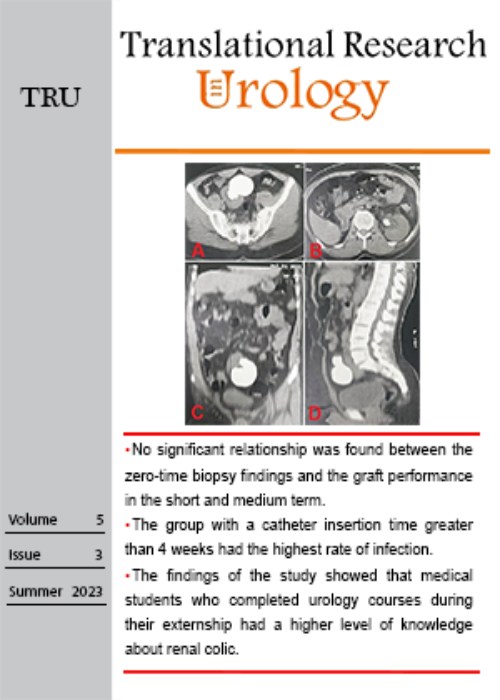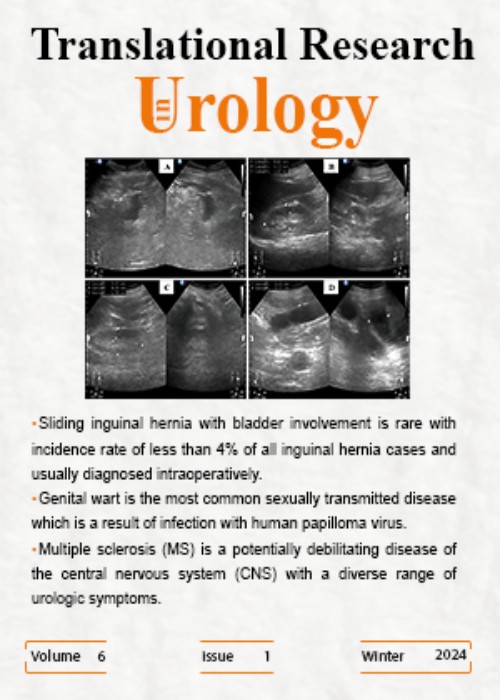فهرست مطالب

Journal of Translational Research in Urology
Volume:5 Issue: 3, Summer 2023
- تاریخ انتشار: 1402/06/10
- تعداد عناوین: 8
-
-
Pages 102-104
The safe intrarenal pressures to avoid endourological procedure complications are different in various surgeries, but the most cited pressure in the literature is lower than 30cm H2O. In semi-rigid ureteroscopic procedures use of a smaller-size ureteroscope with continuous flow and avoiding of manual pressure system is recommended. In RIRS surgery with a suction system, larger UAS, and smaller size fURS are recommended. During the miniaturized PCNL approach use of the suction system is strongly recommended. The use of intraluminal drug administration to relax the ureteral muscle is controversial but may be beneficial. According to the shreds of evidence, the IRP and its obvious relation to postoperative complications should be considered an important factor in daily endourology practice.
Keywords: Intrarenal Pressures, Postoperative complications, Endourology -
Pages 105-108Introduction
The pelvic kidney is a rare anomaly that is prone to stone formation due to its abnormal position. Performing minimally invasive procedures can be risky because of the abnormal anatomy and uncertain blood supply of these kidneys.
Case PresentationIn this study, we present a 43-year-old man who had an 8-cm stone in the right ectopic pelvic kidney concurrent with an obstructive stone in his left kidney. He underwent simultaneous open pyelolithotomy of the right pelvic kidney and percutaneous nephrolithotomy of the left kidney at one stage.
ConclusionIf possible, surgery for pelvic kidney stones should be performed using minimally invasive techniques. But in some cases, reasons such as the abnormal position of the kidney and the possibility of damage to the surrounding organs as well as the size of the stone can make open surgery unavoidable.
Keywords: Ectopic kidney, Open pyelolithotomy, renal stones -
Pages 109-114Introduction
Bladder injuries can occur due to several etiologies, such as traumatic injuries, abdominal surgeries, or even idiopathic. One of the most common causes of bladder injuries in paediatrics after traumatic events is abdominal surgeries, especially hernia repair surgery.
MethodsSeveral types of iatrogenic bladder injuries due to hernia repair surgery were reported again to suggest that surgeons pay more attention to the specific anatomy of the bladder in kids during supra-pubic and abdominal surgeries, especially the hernia repair surgery.
ResultsOur analysis showed that most cases were not diagnosed before 24 hours post-operation (61%). Bladder injury has specific symptoms so it can be misdiagnosed. Nine reports claimed that the surgeons found out about the bladder injury right after the injury happened during the surgery. All intraoperative diagnosed cases had their bladder repaired during the inguinal hernia surgery. Most cases were boys (21), 2 were girls, and eight did not mention gender. Most kids (55%) experienced severe or at least moderate to severe symptoms of bladder injury. Three kids passed septic shock as a severe adverse effect of bladder injury.
ConclusionSeveral types of iatrogenic bladder injuries due to hernia repair surgery were reported again to suggest that surgeons pay more attention to the specific anatomy of the bladder in kids during supra-pubic and abdominal surgeries, especially the hernia repair surgery.
Keywords: Bladder injury, Pediatrics, Hernia -
Pages 115-120IntroductionThis study was conducted to compare the level of knowledge of medical interns who have gone through the urology course during their externship with interns who have not gone through the urology course during their externship.MethodsIn this cross-sectional study that was conducted in the year 2021 at the Isfahan University of Medical Sciences, Isfahan, Iran, 97 medical interns entered in September 2014, 38 of whom underwent a neurosurgery course and 59 underwent a urology course and the level of public awareness about renal colic It was studied in them.ResultsThe total evaluation score in the neurosurgery group was 71.79±13.93 and the urology group was 85.83±7.19, and the students who completed the urology course were significantly higher than the average (P-value<0.001). The average percentage of correct answers to questions in the field of differential diagnosis was 25.39±4.55, the field of use of painkillers was 78±19.77, and the field of emergency intervention was 83.3%±18.41 in all students. The average percentage of correct answers to the differential diagnosis questions in the neurosurgery and urology groups was 22.5±5.15 and 27.25±2.9, respectively, and the difference between the two groups was significant (P-value<0.001).ConclusionThe findings of the present study show that the medical students who completed the urology course during the externship have a higher level of knowledge about renal colic than the students who completed the neurosurgery course.Keywords: extern, Medical Student, Renal colic
-
Pages 121-127IntroductionKidney transplantation is the most definitive treatment for end-stage kidney failure. The purpose of this research is to investigate the impact of zero-time histopathological findings on kidney graft function and survival and the opportunity of performing interferences, based on it, in the immunosuppression regime of transplant patients.MethodPatients who underwent kidney transplantation from a deceased donor between 2018 and 2021 in Shariati Hospital were studied. They underwent wedge biopsy of the kidney graft just after reestablishing vascular perfusion, and the samples were subjected to histopathology examination according to the Banff scoring system. Afterward, the patients underwent 1-month, 3-month, and 6-month follow-ups with the serum creatinine levels and estimated glomerular filtration rate.ResultsThe main findings in the histopathological examination of the biopsies were acute tubular necrosis (62%), mesangial proliferation (2.5%), glomerular thrombosis (7.2%), arteriolar hyalinosis (7.2%), interstitial fibrosis and inflammation (23%). The score of most of the findings was mild and, C4D was also negative in all patients. Seven patients were affected by the delayed graft function (DGF) and among them, glomerulosclerosis was observed in 57%, arterial intimal fibrosis in 7.1%, and interstitial fibrosis in 8.4%. In the 6-month follow-up, the trend of creatinine and GFR of these patients was not as good as the other patients. Although they were not statistically significant.ConclusionStatistically, no significant relationship was found between the zero-time biopsy findings and the graft performance in the short and medium term. Although this is not sufficient for the conclusion due to the small volume of samples.Keywords: Kidney Transplantation, Zero-Time Biopsy, Deceased Donor, Estimated Glomerular Filtration Rate
-
Pages 128-135IntroductionThis study was planned and implemented with the aim of investigating the laboratory diagnostic markers of renal patients with COVID-19.MethodsIn this analytical cross-sectional study, by referring to the Department of medical records and health information system (HIS) and reviewing the files of kidney patients with covid-19 admitted from March 20, 2020, to March 19, 2021, in Taleghani Educational Hospital as the center of covid-19 disease in Abadan city, the information of patients were received.ResultsIn this research, 125 patients were studied, of which 77 were men (61.6%) and 48 (38.4%) were female. The results showed that among the laboratory and clinical markers, fasting blood sugar (FBS), potassium (K), blood urea nitrogen (BUN), creatinine, serum glutamic oxaloacetic transaminase (SGOT), Serum glutamate pyruvate transaminase (SGPT), erythrocyte sedimentation rate (ESR), C-reactive protein (CRP), lactate dehydrogenase (LDH) and respiratory rate (RR) were higher than the normal range and oxygen saturation (SpO2) was lower than the normal range. Also, a significant relationship was found between SpO2 index and the outcome of the disease, blood type O, intubation, K, International normalized ratio (INR), prothrombin time (PT), mean corpuscular hemoglobin concentration (MCHC), sore throat, care in the intensive care unit (ICU) and respiratory rate.ConclusionResults showed that FBS, renal markers, inflammatory markers and liver markers were higher than the standard range in renal patients with COVID-19, and between the reduction of SpO2 and some clinical and laboratory diagnostic markers was a significant relationship.Keywords: kidney disease, COVID-19, SpO2
-
Pages 136-141IntroductionCentral venous catheter (CVC) infection is related to important morbidity and mortality in hemodialysis (HD) patients, even though they are routinely used as the primary vascular access for many HD patients. The goal of this study was to determine the prevalence and bacterial factors causing central venous catheter infections in hemodialysis patients in Abadan educational hospitals.MethodsIn this study, from March 21, 2019, to March 19, 2020, information about patients with End-Stage Renal Disease (ESRD) who were referred to educational hospitals of Abadan University of Medical Sciences, including Frequency distribution of patients by gender and age, Duration of hemodialysis, embedded catheters, underlying disease, signs of clinical infection of the insertion site of the catheter in patients, antibiotics used in infectious patients were obtained through checklists and medical records.ResultsSeventy-six specimens of central venous catheter-related infections occurred in patients’ patients undergoing hemodialysis therapy. Among these cases, 40.8% (31) were male and 59.2% (45) were female. Forty-four (57.9%) patients with infection had femoral vein catheter placement. 82.9% of patients had more than twice-a-week hemodialysis sessions. Staphylococcus aureus was the most common bacterium isolated from bloodstream infections, accounting for 50% (45) of the cases.ConclusionsProlonged central venous catheter use is a major risk factor for infection in hemodialysis patients. For empirical treatment, both Staphylococcus aureus and Gram-negative microorganisms must be considered. Compliance with hygienic measures and the careful use of antibiotics are suggested for lowering the risk of drug resistance.Keywords: infections, Central Venous, Renal Dialysis
-
Pages 142-146IntroductionTorsion of the testicle is one of the most common emergencies in urology, and being aware of its symptoms can lead to timely diagnosis and appropriate treatment. In case of insufficient fixation or the absence of fixation, the testicle twists around the spermatic axis of the cord and causes ischemia due to interruption of venous and arterial blood flow to the testicle. The occurrence of testicular torsion is sudden and may lead to the loss of the testicle.MethodsThis study is a cross-sectional study that was conducted in 1401 on medical interns entering Mehr 1394 of Isfahan University of Medical Sciences. The inclusion criteria included: studying in the medical internship course at Isfahan University of Medical Sciences and entering the month of 2014. Also, medical interns who did not want to participate in this study were not included in the study, and people who provided incomplete answers or selected multiple options for a question in the questionnaire and did not answer more than 20% of the questions in total were excluded from the study.ResultsOf the 133 students examined, 14 (10.5%) had excellent knowledge, 34 (25.6%) had good knowledge, 51 (38.3%) had average knowledge, and 34 (25.6%) had poor knowledge. They were about testicular torsion. The students who passed the urology course in the external course had a higher level of knowledge than the students who did not pass that unit, so the percentage of people with a high level of knowledge (score 17-20) in the urology group was 18.6 percent. And in the neurosurgery group, it was 1.6%. Also, the percentage of people with favorable information in the above two groups was 45.7 and 3.2 percent, respectively (P-value<0.001).ConclusionThe findings of the present study showed that the medical students who completed the urology course during the externship have a higher level of knowledge about testicular torsion than the students who completed the neurosurgery course.Keywords: testicular torsion, awareness, internship


